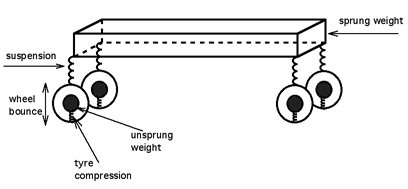Car Unsprung weight (mass) explained

In a ground vehicle with a suspension, the unsprung weight (or the unsprung mass) is the mass of the suspension, wheels or tracks (as applicable), and other components directly connected to them, rather than supported by the suspension. (The mass of the body and other components supported by the suspension is the sprung mass.) Unsprung weight includes the mass of components such as the wheel axles, wheel bearings, wheel hubs, tires, and a portion of the weight of driveshafts, springs, shock absorbers, and suspension links. Even if the vehicle's brakes are mounted outboard (i.e., within the wheel), their weight is still considered part of the unsprung weight.
Effects of unsprung weight
The unsprung weight of a wheel controls a trade-off between a wheel's bump-following ability and its vibration isolation. Bumps and surface imperfections in the road cause tire compression—which induces a force on the unsprung weight. The unsprung weight then responds to this force with movement of its own. The amount of movement, for short bumps, is inversely proportional to the weight - a lighter wheel which readily moves in response to road bumps will have more grip and more constant grip when tracking over an imperfect road. For this reason, lighter wheels are sought especially for high-performance applications. In contrast, a heavier wheel which moves less will not absorb as much vibration; the irregularities of the road surface will transfer to the cabin through the geometry of the suspension and hence ride quality and road noise are deteriorated. For longer bumps that the wheels follow, greater unsprung mass causes more energy to be absorbed by the wheels and makes the ride worse.
Pneumatic or elastic tires help by providing some springing for most of the (otherwise) unsprung mass, but the damping that can be included in the tires is limited by considerations of fuel economy and overheating. The shock absorbers, if any, damp the spring motion also and must be less stiff than would optimally damp the wheel bounce. So the wheels execute some vibrations after each bump before coming to rest. On dirt roads and perhaps on some softly paved roads, these motions form small bumps, known as corrugations, washboarding or "corduroy" because they resemble smaller versions of the bumps in roads made of logs. These cause sustained wheel bounce in subsequent vehicles, enlarging the bumps.
High unsprung weight also exacerbates wheel control issues under hard acceleration or braking. If the vehicle does not have adequate wheel location in the vertical plane (such as a rear-wheel drive car with Hotchkiss drive, a live axle supported by simple leaf springs), vertical forces exerted by acceleration or hard braking combined with high unsprung mass can lead to severe wheel hop, compromising traction and steering control.
As mentioned above, there is a positive effect of unsprung mass. High frequency road irregularities, such as the gravel in an asphalt or concrete road surface, are isolated from the body more completely because the tires and springs act as separate filter stages, with the unsprung weight tending to uncouple them. Likewise, sound and vibration isolation is improved (at the expense of handling), in production automobiles, by the use of rubber bushings between the frame and suspension, by any flexibility in the frame or body work, and by the flexibility of the seats.
Unsprung weight and vehicle design
Unsprung weight is largely a function of the design of a vehicle's suspension and the materials used in the construction of suspension components. Beam axle suspensions, in which wheels on opposite sides are connected as a rigid unit, generally have greater unsprung weight than independent suspension systems, in which the wheels are suspended and allowed to move separately. Heavy components such as the differential can be made part of the sprung weight by connecting them directly to the body (as in a de Dion tube rear suspension). Lightweight materials, such as aluminum, plastic, carbon fiber, and/or hollow components can provide further weight reductions at the expense of greater cost and/or fragility.
Inboard brakes can significantly reduce unsprung weight, but put more load on half axles and (constant velocity) universal joints, and require space that may not be easily accommodated. If located next to a differential or transaxle, waste heat from the brakes may overheat the differential or vice versa, particularly in hard use, such as motor racing. They also make anti-dive suspension characteristics harder to achieve as the moment created by the act of braking is not reacted on the suspension arms.
The Chapman strut used the driveshafts as suspension arms, thus requiring only the weight of one component rather than two. Jaguar's patented independent rear suspension (IRS) similarly reduced unsprung weight by replacing the upper wishbone arms of the suspension with the drive shafts, as well as mounting the brakes inboard in some versions.
Scooter-type motorcycles use an integrated engine-gearbox-final drive system that pivots as part of the rear suspension and hence is partly unsprung. This arrangement is linked to the use of quite small wheels, further impacting the reputation for road-holding.


